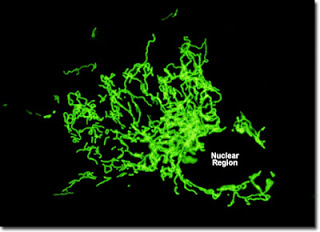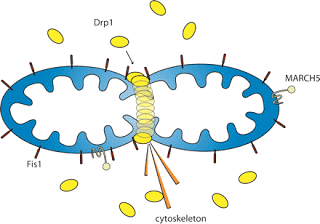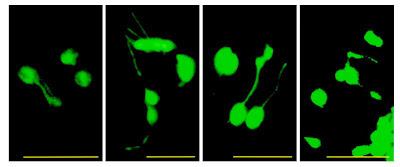Biology
Biology Concepts ? mitochondrial dynamics
For mitochondria at least, this picture is misleading. In many cells, the mitochondria do not look like independent structures floating within the cell. They look more like strands of spaghetti on your plate. Mitochondria can also move around, they fuse together and break apart, they are recruited to different subcellular areas based on energy need, and they can exchange organellar content.
- Mitochondria Evolved By Endosymbiosis
How did a situation evolve in which an organelle contains genetic information for some of its functions, while others are coded in the nucleus? Figure 3.41 shows the endosymbiosis model for mitochondrial evolution, in which primitive cells captured bacteria...
- Mitochondrial Dna Organization Is Variable
KEY CONCEPTS:Animal cell mitochondrial DNA is extremely compact and typically codes for 13 proteins, 2 rRNAs, and 22 tRNAs. Yeast mitochondrial DNA is 5× longer than animal cell mtDNA because of the presence of long introns. Animal mitochondrial...
- Organelles Have Dna
KEY TERMS:Maternal inheritance describes the preferential survival in the progeny of genetic markers provided by one parent. Extranuclear genes reside outside the nucleus in organelles such as mitochondria and chloroplasts. Cytoplasmic inheritance is...
- Eukaryotic Cells
Cell Webquest ? Ms. Carter Eukaryotic Cells California Standard: Cell Biology 1.a, e, f, g CELL BIOLOGY 1 a. The fundamental life processes of plants and animals depend on a variety of chemical reactions that occur in specialized areas of the organism?s...
- #94 Structure And Function Of The Mitochondrion
The mitochondrion is a power plant and industrial park of the cell where energy stored in the bonds of carbohydrates is converted to a form more useful to the cell (ATP) and certain essential biochemical conversions of amino acids and fatty acids occur....
Biology
Biological Fusion Energy
Biology Concepts ? mitochondrial dynamics
 |
Stars are the largest fusion reactors around, and organisms do use some of the energy our Sun produces by joining two hydrogen atoms into a helium atom - remember photosynthesis? Fission reactors are closer to home, but are much less efficient -- and can melt down and kill us all. Cellular fission and fusion are about joining and splitting things as well, just without the release of energy. |
In the typical picture of a working cell, you would see millions of vacuoles traveling around, joining together and splitting off from organelles. The general proposition is that a bag of stuff fuses(joins) or fissions (separates) from another bag of stuff.
In physics, fission and fusion can be sources of great energy, but in cells they usually require an input of energy. If the processes were the same, we could run the world?s electronics on biology power ? a true cell phone!
In physics, fission and fusion can be sources of great energy, but in cells they usually require an input of energy. If the processes were the same, we could run the world?s electronics on biology power ? a true cell phone!
Fusing and fissioning are easy for vacuoles, they have one membrane. But the mitochondria and chloroplasts we have been looking at for the past few posts have very specific, double membrane structures. The outer membrane and inner membranes form a intermembrane space that is crucial for their function, and the inner membranes have specific forms and structures that are necessary to make carbohydrate or ATP.
Wouldn?t fusing or splitting these organelles destroy the membrane structures needed to maintain their functions? Indeed, the typical cartoon of the cell shows individual mitochondria or chloroplasts floating around in the cell, doing their jobs, but not interacting with the other organelles or with each other.
 |
The structure pictured in green is, believe, it or not, the mitochondrion of a fibroblast (fibro = fiber and blast = sprout) cell, one that makes connective tissue. This doesn?t look much like the mitochondrion in the biology books, does it? The different strands join together and separate constantly. |
All these features (shape, communication, movement, fusion, fission, and exchange) are dynamic, meaning that they change with time and are regulated. First recognized as a regulated process about 10 years ago, this has spawned a new line of research called mitochondrial dynamics.
Changes in morphology are also involved in progression through the cell cycle. A 2009 study showed that in cultured cells, the mitochondria must fuse together into branched networks in order for the cell to enter the phase when it replicates its DNA. Now it appears that this changing mitochondrial morphology is important for other shifts in cell fate. The same group that conducted the 2009 study above showed in May 2012 that mitochondrial fusion and fission are important for oogenesis differentiation (the changes an egg goes through to become different types of cells) in fruit fly egg chambers, implying their importance in differentiation of other cells too.
It appears that fusion and fission help to maintain the correct number of mitochondria, but also work in the preservation of mitochondrial function. Defective proteins can be kicked out if there are normal proteins to replace them. Fusion of mitochondria can provide these normal proteins. In other instances, low oxygen or low carbohydrate concentrations can bring fission and fusion so that the mitochondria can share nutrients and prevent their own degradation.
Most importantly, defective mitochondrial DNA (mtDNA) can be minimized by combining or being replaced it with normal DNA from functioning mitochondria. In most cases, recombination of DNA serves to increase genetic diversity, but with mtDNA it seems the opposite effect is desired. Recombining and exchanging DNA serves to maintain a single uniform genome for all the mitochondria; fusion can preserve the integrity of the mitochondrial genome. Mutations or defects in either exchange, fission, or fusion systems result in poor mitochondrial function and identifiable diseases.
People with Charcot-Marie Tooth have very high arches, and are most often double jointed. Would you enjoy having your knees bend the other direction? I can tell you from personal experience, that double jointed people are very hard to wrestle against. They can slip out of whatever hold you try on them. |
If the fusion of mitochondria is defective, a disease called Charcot-Marie-Tooth type 2a may result. This is a neuronal degenerative disease that usually affects the lower extremities more than the arms. Most cases are caused by defects in the cells that surround the neural axon (the long projection between the cell body and the connection point to other neurons), but in type 2a, the defect is in the axon, specifically the inability of mitochondria to fuse. Therefore, fusion must be important.
In Huntington?s disease, there is too much mitochondrial fission. Huntington?s chorea (chorea = dance, patients with this disease develop large uncontrollable movements that make it look like they are dancing). The cause is an expansion in the huntingtin gene (yes, I spelled it right); a three DNA base repeat (CAG) is mutated and becomes repeated too many times. This affects the function of the huntingtin protein. The age of onset and speed of progression are related to how expanded the triplet repeat is. As of today, this autosomal dominant genetic disease (only need to inherit one mutant gene for it to occur) is untreatable and fatal.
However, the mechanism by which this mutation causes neuron degeneration is just becoming clear. A 2010 study indicated that the mutant huntingtin protein interacts with the proteins that control mitochondrial fission and makes them overactive. Too much fission disrupts mitochondrial functions and the neurons become defective and then die.
Even more important, in terms of numbers of people affected, is the link between reduced mitochondrial fission and Alzheimer?s disease. Scientists know that it was the build up of amyloid protein that promotes neuron degeneration, but until recently, they didn?t know how it was occurring. It turns out that the plaque proteins can stimulate nitric oxide production, which then damages the fission proteins of the mitochondria.
 |
DRP1 proteins are important for the fission of a mitochondrion into two mitochondria. They oligomerize (join together in groups) and pinch the mitochondria apart. Nitric oxide can damage the DRP1 proteins ? so no mitochondrial fission. |
This is huge news because preventing this nitric oxide damage might be a way to slow or stop Alzheimer?s progression. This is a difficult area of research, since nitric oxide is important in many biochemical pathways; just shutting down nitric oxide production everywhere in the body would lead to defective hair growth, blood vessel pressure control, abnormal blood clotting and atherosclerosis, ??oh, and Viagra wouldn?t work either.
The movement of mitochondria within cells is also crucial for their function. The longest cells in your body are your motor neurons. A single cell can be several feet long. Your mitochondria must get to where they are needed along the axon of the neuron, and this requires regulated transport and communication.
Defective transport is one outcome during Charcot-Marie-Tooth type 2a defective mitochondrial fusion and in overstimulation of mitochondrial fission in Huntington?s disease. In addition, defective axonal transport of mitochondria may turn out to be an important early defect in Alzheimer?s disease. In fact, defective transport of mitochondria may play a role in Parkinson?s disease, amyotrophic lateral sclerosis (Lou Gehrig?s disease) and other neurodegenerative diseases that involve defective mitochondrial fusion and fission.
Why might this be?.. I?m not sure, but here is a guess. Defective fusion or fission leads to defective function ? defective function leads to reduced ATP formation ? reduced ATP results in defective energy-requiring functions of the cell, like transport of mitochondria from one place to another. I have no evidence for this, but it is a logical, testable hypothesis. It could be that defective transport is an effect, not a cause, of these diseases -at least in part.
 |
Two of our more famous Parkinson?s patients; Muhammed Ali and Michael J. Fox. Float like Marty McFly and sting like a bee? |
For Parkinson?s disease, a 2009 study showed that defective mitochondrial transport occurred due to dysfunction in the fusion/fission system, independent of changes in the ATP level. However, ATP production is not the only function of mitochondria. They also work in regulating the amount of calcium in the cell, and altered calcium levels can lead to disruption of the cytoskeletal transport mechanisms. Maybe I need to tweek my hypothesis; it is fusion/fission-mediated defects in several mitochondrial functions that then cause axonal transport changes that are noted in many neurodegenerative disorders. Now design an experiment to test it - this is how scientists go about their work.
So we see that the mitochondria are not static, they are changing all the time and that these changes are crucial for their function and integrity. Here is our exception in the similarities of chloroplasts and mitochondria. It would seem, at least based on current evidence, chloroplasts are relative loners.
This is not to say that can?t be dynamic. We have seen that chloroplasts have a definitive inheritance pattern, either maternal or paternal, and they will fight to maintain this pattern. Chloroplast fusion has been most often described in the zygote(initial cell formed by fusion of the gametes during fertilization, from Greek zygota = joined or yoked together) of algae. In these cases, which are still rare, the chloroplast genome of one of the two fused organelles will be degraded. Fusion of other chloroplasts, as in mature plant cells, either does not occur or has not been studied, because I can?t find any publications describing it.
 |
These are examples of the dynamic activities of chloroplasts. Stromuleconnections can be formed between chloroplasts for the passage of organelle contents. They are usually 0.5 microns in diameter (1/500,000 of a meter) and can be found in all types of plastids. Their function ? not completely known yet. |
On theother hand, chloroplasts aren?t complete loners either. As far back as the 1960?s there were reports saying that chloroplasts might have certain connections at certain times. More recent studies indicate that small connections can be formed between chloroplasts, often called tubular connections or stromules. It is interesting that stromules can be formed between chloroplasts and mitochondria. It is believed that this is one way the plant cell keeps these two organelles close to one another, since their functions, products, and by-products are so interrelated.
You might ask why the mitochondria and chloroplasts that have so much in common differ in their relative dynamic properties. They were both once free organisms that had to have lots of interactions with other members of their species, but only the mitochondria seemed to have preserved it. Next week, we will look into how this mitochondrial dynamism is even more crucial organism survival ? by regulating cell death. Believe it or not, cells have to know how to die well.
Kasturi Mitra, Richa Rikhy, Mary Lilly, and Jennifer Lippincott-Schwartz (2012). DRP1-dependent mitochondrial fission initiates follicle cell differentiation during Drosophila oogenesis J Cell Biol DOI: 10.1083/jcb.201110058
For more information or classroom activities on mitochondrial dynamics or cellular differentiation, see:
Mitochondrial dynamics ?
http://mitodyn2011.azuleon.org/
http://www.its.caltech.edu/~chanlab/main%20pages/research.html
http://www.youtube.com/watch?v=0NmBaw3grr4
http://www.plantmitochondria.net/Plant_Mitochondria/Movies.html
http://www.nature.com/scitable/topicpage/mitochondrial-fusion-and-division-14264007
http://biology--dev.about.com/b/2010/04/23/mitochondrial-fusion.htm
http://www.sciencedaily.com/releases/2010/04/100415125942.htm
http://www.sciencedaily.com/releases/2011/01/110124162712.htm
http://www.ellisonfoundation.org/content/does-mitochondrial-fusion-protect-against-mitochondrial-dna-mutations-during-aging
www.its.caltech.edu/~chanlab/PDFs/Griffin_et_al_BBA_2006.pdf
https://research.uiowa.edu/arra/project/176
- Mitochondria Evolved By Endosymbiosis
How did a situation evolve in which an organelle contains genetic information for some of its functions, while others are coded in the nucleus? Figure 3.41 shows the endosymbiosis model for mitochondrial evolution, in which primitive cells captured bacteria...
- Mitochondrial Dna Organization Is Variable
KEY CONCEPTS:Animal cell mitochondrial DNA is extremely compact and typically codes for 13 proteins, 2 rRNAs, and 22 tRNAs. Yeast mitochondrial DNA is 5× longer than animal cell mtDNA because of the presence of long introns. Animal mitochondrial...
- Organelles Have Dna
KEY TERMS:Maternal inheritance describes the preferential survival in the progeny of genetic markers provided by one parent. Extranuclear genes reside outside the nucleus in organelles such as mitochondria and chloroplasts. Cytoplasmic inheritance is...
- Eukaryotic Cells
Cell Webquest ? Ms. Carter Eukaryotic Cells California Standard: Cell Biology 1.a, e, f, g CELL BIOLOGY 1 a. The fundamental life processes of plants and animals depend on a variety of chemical reactions that occur in specialized areas of the organism?s...
- #94 Structure And Function Of The Mitochondrion
The mitochondrion is a power plant and industrial park of the cell where energy stored in the bonds of carbohydrates is converted to a form more useful to the cell (ATP) and certain essential biochemical conversions of amino acids and fatty acids occur....
